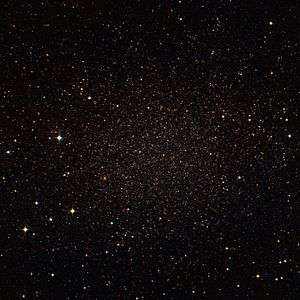Sculptor Dwarf Galaxy
| Sculptor Dwarf Elliptical Galaxy | |
|---|---|
 | |
| Observation data (J2000 epoch) | |
| Constellation | Sculptor |
| Right ascension | 01h 00m 09.3s[1] |
| Declination | −33° 42′ 33″[1] |
| Redshift | 110 ± 1 km/s[1] |
| Distance | 290 ± 30 kly (90 ± 10 kpc)[2][3] |
| Apparent magnitude (V) | 10.1[1] |
| Characteristics | |
| Type | E[1] |
| Apparent size (V) | 39′.8 × 30′.9[1] |
| Other designations | |
| Sculptor Dwarf Spheroidal,[1] PGC 3589,[1] MCG-06-03-015 | |
The Sculptor Dwarf Galaxy (also known as Sculptor Dwarf Elliptical Galaxy or the Sculptor Dwarf Spheroidal Galaxy) is a dwarf spheroidal galaxy that is a satellite of the Milky Way. The galaxy lies within the constellation Sculptor. It was discovered in 1937 by American astronomer Harlow Shapley using the 24-inch Bruce refractor at Boyden Observatory.[4][5] The galaxy is located about 290,000 light-years away from the Solar System. The Sculptor Dwarf contains only 4 percent of the carbon and other heavy elements in our own galaxy, the Milky Way, making it similar to primitive galaxies seen at the edge of the universe.[6]
Metallicity
The metallicity of Sculptor dwarf appears to be broken up into two distinct groups, one with [Fe/H] = -2.3 and the other with [Fe/H] = -1.5.[7] Similar to many of the other Local Group galaxies, the older metal-poor segment appears more extended than the younger metal-rich segment.[8]
Gallery
 Sculptor Dwarf Galaxy taken by the 2.2-meter MPG/ESO telescope.[9]
Sculptor Dwarf Galaxy taken by the 2.2-meter MPG/ESO telescope.[9]
References
- 1 2 3 4 5 6 7 8 "NASA/IPAC Extragalactic Database". Results for PGC 3589. Retrieved 2006-12-03.
- ↑ I. D. Karachentsev; V. E. Karachentseva; W. K. Hutchmeier; D. I. Makarov (2004). "A Catalog of Neighboring Galaxies". Astronomical Journal (abstract). 128 (4): 2031–2068. Bibcode:2004AJ....127.2031K. doi:10.1086/382905.
- ↑ Karachentsev, I. D.; Kashibadze, O. G. (2006). "Masses of the local group and of the M81 group estimated from distortions in the local velocity field". Astrophysics. 49 (1): 3–18. Bibcode:2006Ap.....49....3K. doi:10.1007/s10511-006-0002-6.
- ↑ Shapley, H., (1938) Harvard Bull. 908.
- ↑ Shapley H (1938). "Two Stellar Systems of a New Kind". Nature. 142 (3598): 715–6. Bibcode:1938Natur.142..715S. doi:10.1038/142715b0.
- ↑ Astronomers Detect Dust Around a Primitive Star, Shedding New Light on Universe’s Origins Newswise, Retrieved on January 19, 2008.
- ↑ S.R. Majewski; et al. (20 July 1999). "An Internal Second-Parameter Problem in the Sculptor Dwarf Spheroidal Galaxy". The Astrophysical Journal. 520 (1). arXiv:astro-ph/9905238
 . Bibcode:1999ApJ...520L..33M. doi:10.1086/312133.
. Bibcode:1999ApJ...520L..33M. doi:10.1086/312133. - ↑ van den Bergh, Sidney (April 2000). "Updated Information on the Local Group". The Publications of the Astronomical Society of the Pacific. 112 (770): 529–536. arXiv:astro-ph/0001040
 . Bibcode:2000PASP..112..529V. doi:10.1086/316548.
. Bibcode:2000PASP..112..529V. doi:10.1086/316548. - ↑ "Sculptor Dwarf Galaxy". Retrieved 17 September 2015.
External links
- The Sculptor Dwarf Galaxy on WikiSky: DSS2, SDSS, GALEX, IRAS, Hydrogen α, X-Ray, Astrophoto, Sky Map, Articles and images
Coordinates: ![]() 01h 00m 09.3s, −33° 42′ 33″
01h 00m 09.3s, −33° 42′ 33″
